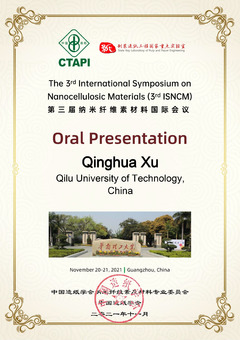Gelatin films reinforced by nanocellulose-tannin microgel towards sustainable active food packaging
ID:20
Submission ID:80 View Protection:PRIVATE
Updated Time:2021-11-03 16:00:37
Hits:1093
Oral Presentation
Abstract
The overuse of plastic products as packaging materials poses a serious threat to nature and human beings. Therefore, development of packaging materials from renewable natural resources, such as cellulose, protein, starch, etc. has received increasing attention. Gelatin films with remarkable safety, biodegradability and biocompatibility, demonstrate prospective application in the food packaging industry. However, their weak mechanical properties and hydrolytic stability make them inferior to the commercial synthetic polymeric materials in the more practical and versatile application as packaging materials. Nanocellulose, extracted from lignocellulosic materials, has been widely used as reinforcement filler due to its high Yong’s modulous. In this work, tannin-nanocellulose microgels (TANC) were firstly prepared using dialdehyde nanocellulose and tannin through the condensation reaction between the aldehyde groups and active hydrogen on tannin molecules. Then varied ratio of microgel were incorporated into gelatin matrix as reinforcement filler to obtain gelatin/nc@tannin films for the sustainable active packaging materials. The residual aldehyde groups on nanocellulose in the TANC could react with gelatin through Schiff base reaction, and it is expected that the mechanical properties of the composite films would be boosted due to the covalent bonds and the microgel reinforcement effect. The obtained composite films were characterized by using FT-IR, XRD and TG. Their surface hydrophilicity, UV blocking, antioxidant and mechanical properties were measured to evaluate their potential application in food packaging. Adsorption band at 1730 cm-1 corresponding to was observed in the FTIR spectra of the microgel. This band disappeared in the spectra of composite films, suggesting the successful reaction between gelatin and TANC. The thermal stability of the composite films improved compared with the pure gelatin film, may be due to the high chemical and thermal stabilities of tannin. The X ray diffractogram of the composite films show peaks at 2θ of 14-18º, 22º and 34º, corresponding to (1-10), (110), (200) and (004) crystal planes of cellulose, and peaks at 2θ of 8ºattributed to the triple-helix configurations of gelatin, indicating the incorporation of TANC into gelatin matrix. Compared with the pure gelatin film, the surface hydrophobicity of the composite films increased and water solubility decreased. The tannin-containing films displayed excellent antioxidant and UV-blocking properties, scavenging about 80% of DPPH free radicals and absorbing 80% of ultraviolet light. The tensile strength (TS) of the composite films was improved significantly. It has been doubled to 100 MPa with only 5% of TANC. The composite films still retained a certain strength after soaking in water for 1h. The gelatin-nc@tannin film in this work demonstrated high mechanical properties, oxidation resistance and ultraviolet resistance, which has a prospective application as the sustainable active food packaging.
Submission Author
Xiaodi Huang
Qilu University of Technology
Yawen Sheng
Qilu University of Technology
Lukuan Guo
Qilu University of Technology
Yingjuan Fu
Qilu University of Technology
Qinghua Xu
Qilu University of Technology



Comment submit